Conveyors are a common type of machine used to move materials and are found in many areas of industry and business. The technology can take a number of forms, and differences are primarily a matter of the exact mechanism by which the conveyor moves materials. Conveyors are used to move almost any kind of raw material, parts and finished products in factories, foods in processing plants, crops during harvesting, and packages in distribution centers. They can be passive or powered and may be designed to move its contents a few feet or several miles.
Passive conveyor technology relies on an outside force to move the object and merely provides a means for facilitating such movement. A very simple type of passive conveyor is a roller conveyor. A roller conveyor consists of a series of free-spinning rollers, usually made of metal and mounted on a frame much like rungs on a ladder, but much closer together. An object placed on the conveyor and given a small push glides quickly and easily along the rollers, which reduce friction. Conveyors of this type are common on trucks and in small business and on loading docks.

Powered systems make up the bulk of conveyor technology and take many forms. Powered roller conveyors work much the same way as passive rollers but use machines to spin the rollers that propel the object or package along. Complicated networks of such conveyors are found in package and mail distribution centers. Belt conveyors consist of a large belt that extends between and revolves around two or more cylinder-shaped pulleys. A typical check-out lane in a supermarket is a good example, although these types of conveyors can also be extremely large and are sometimes used to move mining products and wastes over distances of several miles.

Another common type of conveyor is the bucket conveyor, which consists of a series of containers linked together in series and the machinery to move them in a rotating cycle. Bucket conveyors typically carry material from one place to another, where the material is dumped, and then return to the source to be filled again. Chain conveyors are conveyors that use machinery and gears to move a long loop of chain. The chain can have frames, to which parts or goods are attached, or be mounted overhead with hooks.
Many types of modern conveyor technology were developed for specific purposes. Conveyor technology is the heart of the assembly line, one of the most important developments in the history of industry. Magnetic conveyors, monorail conveyors, and even pneumatic conveyors, which use jets of compressed air to move materials, are common in industry today.
Other forms of conveyor technology have been developed over the centuries as well. Screw conveyors, based on the principle of Archimedes' screw, which dates from ancient Greece, consist of a large fixed helix around a central shaft. The whole assembly is encased in a tight fitting cylinder. Material fed into the helix at one end is moved towards the other end as the helix turns.
Logging flumes, a primitive conveyor technology, used the power of flowing water and gravity to carry logs along wooden chutes from logging areas in mountainous areas to rivers or sawmills in valleys and coastal areas. They were used particularly in the American West, although logging flumes have historically been used in other parts of the world as well. Some of them were as long as 60 miles (100 km).
